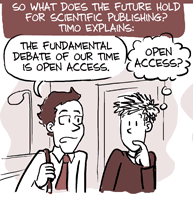
Unless you’ve been under a rock for the last few years, you know that there has been a massive change in education recently. Sure, some of the hyperbole has abated, but there are a lot of people who are still thinking about how a single person might teach more than a classroom. In some cases, they have extended their voice to such a degree that it reaches out to thousands or tens of thousands of people.
Of course, there are issues here. For one thing, this kind of education is mostly one-way. Yes, there are ways of feeding back. A lucky student might be able to grab a sliver of the teacher’s attention, but generally, it’s about the passing of knowledge from one-to-many. Also, students in many cases get together in groups and discuss the work–building on one another’s knowledge. But this isn’t the same as the circle around the sage, the guided conversation that has gone on as long as we have had schools.
Transforming teaching from the kind of conversational learning community that is–at least ideally–found in the university classroom to this sort of massive version is more than just switching media. It means that the teacher has to shift the structure and format of her work. In many cases, this means moving to text, but it also means framing the work more didactically, shaping ideas into units and subunits that can be consumed in little bites.
And this can be amazingly advantageous to many students; students who can’t necessarily get into a classroom each week because of the expense of tuition, because they have full-time jobs and maybe families. Yes, this could potentially be a less rich form of learning than a classroom, but it can reach people who might otherwise never get at that education. It can be provided relatively cheaply, and often for free.
Now some of these are absolute crap. No, check that, I would argue that most are absolute crap. And some have called for their elimination because of that–and a return to more traditional forms of face-to-face learning. The response is natural, and especially when presented with some of these weak examples, it’s clear why they might want to do away with them altogether.
But here’s the key. Many of those who engage in this massified version of learning find their way into the more traditional classroom, or maybe even new forms of learning communities we haven’t even thought of. In other words, although this new form may replace some of the traditional classroom learning, every indication is that there are opportunities for synergy between traditional forms of learning and leveraging new media. There have been calls to move away from massification of learning, and as a person who is interested in networked approaches, I find sympathies with this. But I think a much more reasonable approach is to ask how we can continue to combine these largely “broadcast” models to help enhance what we do in the traditional face-to-face classroom.
So, I say, let’s keep up with this book-writing thing. It might turn out to actually be worthwhile.


Dear Blog
It’s been a good run, but I’m breaking up with you. We just haven’t had enough time for each other in the last few years. There’s the kids, and sexy young things like Twitter and Facebook. We’ll always have the memories, and I’ll make sure your links don’t rot, but I think it’s time we face facts and move on.
Really it doesn’t mean that things are over, just that they need to change. And frankly those changes may take some time, because you aren’t a priority. Let me give you an idea of some things to expect.
First, let’s talk about looks. You look like this largely by accident. I developed this theme as a teaching object for one of my courses, showing students how to use their new HTML and CSS skills to theme a blog. I don’t love it and not just because the footer is mismatched (a simple tiling issue I haven’t had time to deal with in the last, oh, five years.) Many of the choices here had a didactic rather than design reason. Those icons? Made them for a quick lesson on image sprites. Frankly, my design cue more naturally would be Daring Fireball. Keep it simple.
Actually, Medium has largely done what I would do. Some of you may recognize those side-notes–I had them in an earlier iteration of the blog, when I was on a Tufte fanboy kick. I also experimented with tweet-comments. It’s still a little too busy for me, but it’s close.
Second, I tend to be a bit more diffuse in where I write things. I used to tweet on this blog, before there was a Twitter. I didn’t really do anything with Facebook. Now, I split things up more by length than by audience. Twitter for the very short or mobile. Facebook for the largely in-between (and a slightly less public audience, though generally the posts are world-viewable), and then here for longer form. And, I guess, journal articles and the like. I think this becomes an aggregator for all that, slurping up my tweets, posts to FB, Pinterest pins, YouTube videos, and everything else, and slapping them together locally.
There may also be a more cloistered space–perhaps a separate blog–that will be for friends and family and sharing pics and the like. I’m a little sick of Flickr, and FB isn’t a great place for hi-res photo archiving or sharing. It may be I go for one of the OS photo archiving systems for that–I haven’t really decided.
Third, I need to do a better job of putting forward my scholarly and professional side, once I discover it. At a minimum, that means collecting self-archived preprints and the like in an easily grokked space.
So, this probably won’t happen this week or this month. But it will happen, someday. Until then, blog, just chill.
Share this: